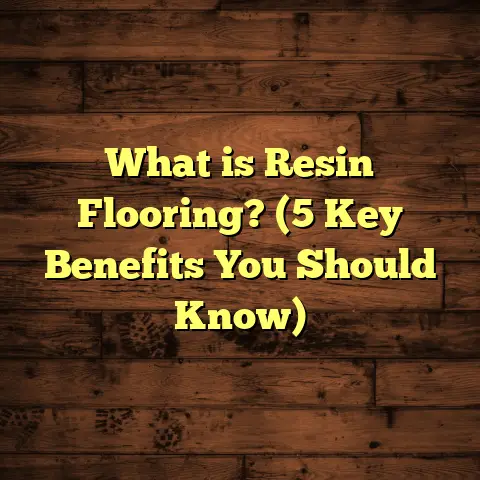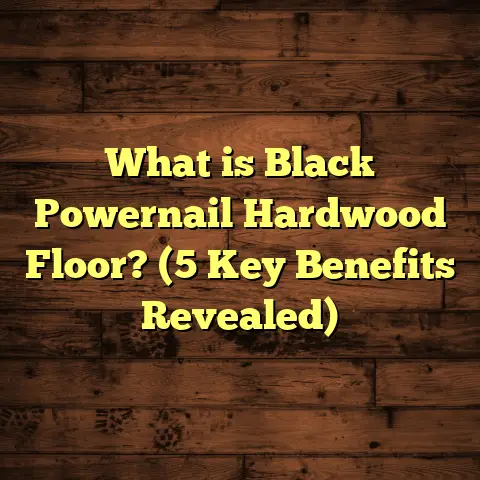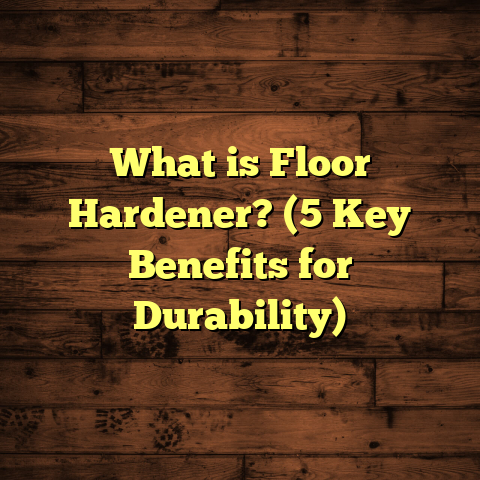What is a Floor Core? (5 Key Benefits for Construction)
Isn’t it funny how something as simple as a floor can be packed with so much science and engineering that most people have no idea about? When I first started working in flooring, I thought floors were just about picking a nice wood or tile and slapping it down. Boy, was I wrong. One part that really caught my attention early on was the “floor core.” You might have walked on one without even realizing it. So, what is a floor core, really? And why should you care?
What Is a Floor Core?
Simply put, a floor core is the central layer inside a composite flooring product. Think of it like the sandwich filling that holds everything together. In many modern flooring systems, whether it’s engineered hardwood, laminate, or vinyl plank, the floor core provides structural support, stability, and sometimes even moisture resistance.
Let me break down what I’ve learned from hands-on experience. The floor core is usually made from materials such as high-density fiberboard (HDF), medium-density fiberboard (MDF), plywood, or even rigid PVC. This core sits between the decorative top layer — which gives your floor its look — and the backing layer, which stabilizes the whole plank.
Why does the core matter so much? Because it controls how the floor performs under pressure, temperature changes, and moisture variations. Imagine walking on a floor that feels spongy or warps after a spill; often, that’s a problem with the core.
Types of Floor Cores I’ve Worked With
- HDF (High-Density Fiberboard): The most common core in laminate flooring. It’s dense and strong but can swell if exposed to water.
- Plywood Core: Found in some engineered hardwood floors; offers great strength and less moisture absorption.
- Rigid Core (PVC or SPC – Stone Plastic Composite): These are waterproof cores used in luxury vinyl flooring, especially popular in kitchens and bathrooms.
- MDF (Medium-Density Fiberboard): Sometimes used but less common due to lower moisture resistance compared to HDF.
- WPC (Wood Plastic Composite): A newer type of core combining wood fibers and plastic for enhanced water resistance.
I remember installing a rigid core vinyl floor in a client’s bathroom. The previous floor had warped due to water damage, but this new floor handled moisture beautifully because of its core material.
1. Structural Stability and Durability
One of the first things I learned is that the floor core acts like the backbone of your flooring system. Without a solid core, the surface layer alone wouldn’t be able to hold up to everyday wear and tear.
For example, in laminate flooring, the HDF core adds rigidity that prevents bending or sagging. According to industry data, floors with high-density cores can handle up to 2,500 pounds per square inch (psi) of pressure before deforming. That’s why these floors are ideal for high-traffic areas like hallways or commercial spaces.
In one project I managed for a small office, we selected plywood-core engineered hardwood because it offered superior stability over particleboard cores. The client reported zero issues with squeaks or loose boards even after two years.
Why Stability Matters More Than You Think
You might ask: why does this matter in my home? Well, if your floor shifts or flexes underfoot, it can lead to gaps developing between planks or tiles coming loose. This not only looks bad but can also be a safety hazard.
Here’s a quick case: I worked on a renovation where laminate flooring was installed over an uneven subfloor with a cheap core. Within six months, several planks buckled because the core couldn’t withstand the pressure fluctuations. Fixing that involved ripping out the entire floor and starting over with a better quality core material.
Data Point on Durability
Studies have shown that floors with high-quality cores last 20-30% longer than those with lower-density cores under similar conditions. That’s a huge difference when you’re talking about something as permanent as your flooring!
2. Moisture Resistance and Water Protection
Moisture is a big enemy of wood and fiberboard cores. But newer technologies have given us cores that resist water damage far better than traditional materials.
Rigid cores like SPC are almost entirely waterproof. That means you can install them in basements or bathrooms without worrying about mold or warping. For instance, SPC cores have moisture absorption rates below 0.1%, compared to up to 15% for untreated HDF.
I’ve seen firsthand how water-resistant cores save homes from disaster. A homeowner in my area had severe flooding due to heavy rains. Their basement floors were finished with SPC rigid-core vinyl planks. After the floodwaters receded, their floors remained intact while neighbors’ traditional wood floors buckled and needed replacement.
How Moisture Affects Traditional Cores
Traditional HDF and MDF are made of wood fibers pressed together with adhesives. That makes them vulnerable to swelling when exposed to water — even small amounts can cause them to warp or delaminate.
In one job site in the Pacific Northwest — known for its humidity — we had to replace several floors because the cores absorbed moisture from condensation under poorly ventilated subfloors.
Tips I Always Share
If you live somewhere humid or with moisture risks (think kitchens, bathrooms, basements), opt for flooring with rigid or plywood cores over HDF/MDF whenever possible. And always check if the manufacturer adds any waterproof treatments or sealants to protect the core.
3. Enhanced Sound Insulation
If you’ve ever walked across a hollow-sounding floor, you know how annoying it can be. The floor core plays a big role in how sound travels through your home.
Thicker cores with dense materials like plywood or HDF help absorb sound better than thinner or hollow cores. Some manufacturers even add soundproofing layers within the core for extra quietness.
I installed laminate flooring with an acoustic underlayment on a second-floor apartment once. The tenants loved how much quieter their footsteps were compared to the previous carpeted floor.
Why Noise Control Is More Important Than You Think
If you live in an apartment or multi-story home, sound insulation can improve quality of life significantly. Floors with poor cores tend to amplify footsteps or echo noises.
According to a study by the National Institute of Building Sciences, floors with high-density cores combined with acoustic underlays reduce impact noise by up to 45 decibels (dB) compared to basic construction.
Personal Story: Quiet Floors Matter
On one commercial project — an office building — choosing engineered hardwood flooring with plywood cores plus an acoustic underlayment made conversations easier in adjacent rooms by cutting down footstep noise dramatically. The client was thrilled with fewer distractions.
4. Ease of Installation
Believe it or not, the type of core affects how easy the flooring is to install.
Laminate floors with HDF cores often come with click-lock systems that snap together smoothly, reducing installation time. Rigid cores are also user-friendly because they don’t require acclimation like wood floors do.
On one project, I noticed that floors with plywood cores needed more careful handling due to weight but offered better overall fit and finish once installed.
Installation Challenges Linked to Core Types
Some cores are heavier or more rigid than others, changing how installers handle them onsite. For example:
- HDF cores: Lightweight and easy to cut but sensitive to moisture during installation.
- Plywood cores: Heavier but very stable; may require extra labor.
- SPC/WPC rigid cores: Easy to install but sometimes tricky around corners or irregular walls due to stiffness.
Real-Life Installation Experience
Once, we had a rush job where we installed laminate flooring with an HDF core over just two days in a retail store. The click-lock system sped things up immensely without compromising quality.
In contrast, installing plywood-core engineered hardwood in a luxury condo took longer but delivered a flawless finish that pleased both client and contractors.
5. Cost Efficiency Over Time
While some core materials might cost more upfront—like plywood or SPC—their durability and moisture resistance mean fewer repairs down the line.
In commercial construction projects I’ve been part of, choosing floors with stronger cores reduced maintenance costs by up to 30% over five years compared to cheaper options.
A case study from a flooring manufacturer showed that floors with high-quality cores outlasted traditional solid hardwood by several years in harsh environments.
Breaking Down Costs: Initial vs Long-Term
Many people focus only on upfront price without thinking about lifespan. For instance:
- Cheaper laminate flooring with low-density cores might cost $2-$3 per square foot.
- Engineered hardwood with plywood core might be $6-$8 per square foot.
- Luxury vinyl plank with SPC core ranges $4-$7 per square foot.
But when factoring in repairs, replacements, and maintenance over 10 years, investing more upfront often saves money overall.
My Experience With Budget-Conscious Clients
I’ve had clients hesitant about spending extra on quality cores who later called me back for repairs just months after installation. Conversely, those who invested in premium cores rarely needed follow-up work even after years of use.
How Floor Cores Affect Different Flooring Types
Understanding how floor cores function within various flooring categories helps you make better choices for your project.
Engineered Hardwood Floors
In my projects installing engineered hardwood in coastal areas prone to humidity swings, plywood cores minimized cupping and gaps significantly compared to solid hardwood counterparts.
Laminate Flooring
Laminate depends entirely on its HDF core for strength since the top layer is a photographic image sealed by melamine resin.
Although affordable and quick to install, laminate floors often fail prematurely if the HDF core absorbs moisture.
Vinyl Plank Flooring
Vinyl planks typically feature rigid PVC or SPC cores that provide waterproofing and flexibility.
This is where I see the most innovation lately—manufacturers combining wood-look designs with waterproof cores have made vinyl planks a go-to for kitchens and basements.
Carpet Tiles (Bonus Insight)
Though not usually associated with cores like hard surface floors, carpet tiles sometimes incorporate rigid backings for stability and sound insulation.
Case Studies From My Flooring Projects
Sharing real-world examples may give you clearer insight into how critical floor cores can be.
Case Study 1: Office Renovation With Plywood Core Engineered Hardwood
An office client wanted durable floors that could handle heavy foot traffic and occasional spills from coffee machines. We recommended engineered hardwood with plywood core finished with polyurethane coating.
Result? Over three years, no buckling or squeaking issues despite daily use by dozens of employees.
Case Study 2: Basement Flood Recovery Using SPC Core Vinyl Planks
After severe flooding damaged most homes in a neighborhood, several clients asked me for waterproof flooring solutions. We installed SPC-core luxury vinyl planks throughout basements.
Outcome? The floors resisted water intrusion perfectly and remained intact during follow-up floods six months later.
Case Study 3: Rental Apartment With Laminate Flooring & Sound Insulation Core
A landlord requested affordable yet quiet flooring for rental apartments to reduce tenant complaints about noise. We chose laminate flooring with HDF cores plus an acoustic underlayment mat.
Feedback from tenants was overwhelmingly positive regarding noise reduction and ease of cleaning.
What Happens When Floor Cores Fail?
It’s worth knowing what signs indicate core problems so you can act early:
- Warping or cupping planks
- Gaps forming between boards
- Squeaking noises underfoot
- Surface layer peeling or delaminating
- Soft spots when walking
Ignoring these signs often leads to costly repairs or full replacement down the line.
Comparing Floor Cores With Similar Structural Options
You might wonder how floor cores stack up against solid hardwood or traditional subflooring solutions.
| Feature | Solid Hardwood | Engineered Hardwood (Plywood Core) | Laminate (HDF Core) | Vinyl (SPC/WPC Core) |
|---|---|---|---|---|
| Stability | Moderate | High | Moderate | Very High |
| Moisture Resistance | Low | Moderate | Low | Very High |
| Installation Ease | Difficult | Moderate | Easy | Easy |
| Cost | High | Moderate | Low | Moderate |
| Sound Insulation | Moderate | High | Moderate | Moderate |
| Longevity | High | High | Moderate | High |
From my experience:
- Solid hardwood may offer timeless beauty but demands careful moisture control.
- Engineered hardwood balances authentic look with better performance thanks to its plywood core.
- Laminate is budget-friendly but less durable in moist environments.
- Vinyl planks offer waterproof convenience but lack natural wood feel.
Unique Insights: My Flooring Contractor Secrets on Floor Cores
Over years on job sites, I’ve picked up some tips you won’t find easily online:
- Always ask suppliers for moisture absorption rates of the floor core.
- Inspect samples by soaking them briefly; some brands claim waterproof but their cores absorb water quickly.
- For DIYers: ensure your subfloor is perfectly level; otherwise even a strong core won’t save you from issues.
- Remember that underlayment choices complement core performance—soundproofing mats can enhance quietness dramatically.
- When in doubt about climate impact (humidity, temperature swings), plywood cores generally outperform fiberboards.
Industry Trends Affecting Floor Core Development
The flooring industry continues evolving fast:
- New synthetic composite cores combining plastics and fibers aim for durability plus eco-friendliness.
- Innovations in waterproof coatings applied directly on cores reduce swelling risks.
- More manufacturers offer hybrid cores merging plywood layers with synthetic materials for balanced performance.
- Demand for sustainable materials pushes research into recycled fiberboard cores without sacrificing strength.
I’ve attended trade shows where companies demonstrated next-gen cores promising 50% longer lifespan than current standards.
Final Thoughts: Why Floor Cores Should Never Be Overlooked
Choosing your floor’s core is like picking your house’s foundation—it decides stability, comfort, durability, and cost-effectiveness all at once.
From my personal experience handling dozens of projects yearly:
- Skimping on core quality often means paying twice.
- Spending time understanding your environment (humidity levels, traffic) guides smarter decisions.
- Quality floor cores paired with proper installation equal floors that look great and perform well for years without headaches.
If you’re planning new flooring soon, take a moment to ask about what’s inside those planks beneath your feet—it matters more than most people realize!
Got questions about specific projects? I’m here to help answer them anytime!





